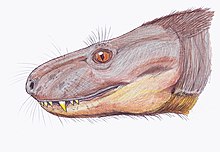Moschowhaitsia
| Moschowhaitsia Temporal range:
| |
|---|---|

| |
Life restoration of Megawhaitsia vjuschkovi
| |
| Scientific classification | |
| Domain: | Eukaryota |
| Kingdom: | Animalia |
| Phylum: | Chordata |
| Clade: | Synapsida |
| Clade: | Therapsida
|
| Clade: | †Therocephalia |
| Family: | †Whaitsiidae |
| Genus: | †Moschowhaitsia Tatarinov, 1963 |
| Type species | |
| †Moschowhaitsia vjuschkovi Tatarinov, 1963
| |
| Other species | |
| |
Moschowhaitsia is an extinct genus of
Classification and taxonomy
Moschowhaitsia is a member of the derived therocephalian
However, later research of therocephalian evolution using
A cladogram depicting the relationships of both M. vjuschkovi and M. lidaqingi is shown below, reproduced from Liu & Abdala (2023) and simplified to show the relationships of whaitsioid therocephalians:[2]
| Eutherocephalia |
| |||||||||||||||||||||||||||||||||||||||||||||||||||||||||||||||||||||||||||
The strict-consensus tree shown above did not recover M. vjuschkovi and M. lidaqingi as each other's sister taxa (found as such in only six of the 30 most parsimonious (i.e. shortest) trees). However, Liu and Abadala (2023) nonetheless assigned M. lidaqingi to Moschognathus as both species show more similarities to each other in morphology than either does to other whaitsiids. Such traits include the number of incisors and postcanine teeth, rugose bone on the front edge of the orbit, and a notch in the maxilla in front of the canine.[2]
See also
References
- .
- ^ hdl:10539/35706.
- ^ a b Tatarinov, L. P. (1963). "A new Late Permian therocephalian". Paleontological Journal. 4: 76–94.
- .
- S2CID 87382966.
- PMID 29018609.
